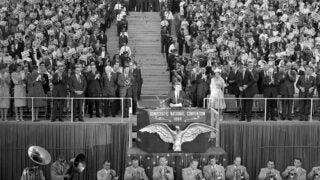Milton Curry Looks to Architecture for Answers to Societal Challenges
For solutions to inequality, marginalization and divisiveness, one of USC’s newest deans wants to tap an unexpected resource: architecture.
It can be easy to take architecture for granted. Sure, Los Angeles residents taking visitors on a tour might point out famous landmarks. The Walt Disney Concert Hall and its soaring curves — designed by Frank Gehry ’54 — or the Stahl House, a modernist paragon in the Hollywood Hills by Pierre Koenig ’52 come to mind.
But consider that many city dwellers spend every minute of urban existence in a space that someone imagined and designed. They could be forgiven for becoming numb to structure.
Milton Curry isn’t one of them.
The 52-year-old professor, who joined USC as dean of the USC School of Architecture in 2017, has spent much of his life thinking about built space. But the power — and responsibility — of an architect goes far beyond being simply a “designer of buildings.”
Curry looks at architecture with a wide lens, where it’s clear that an edifice can have an enormous impact—not only on ease of living, but also on environment, economy, culture and race relations.
This is the kind of provocative thinking that he plans to nurture at the helm of USC’s program. More than half of the people on the planet now live in cities, and that move toward urbanization is only expected to accelerate. Yet the same urbanization movement that can yank people out of poverty and spur innovation can also produce shantytowns and stifling pollution. As Curry sees it, architects are in a unique position to help address these problems. But first, an architect’s role must expand. Under the dean’s watch, he hopes architects become not only masters of the practice, but also keen interpreters of the cultural context and ramifications of their work. Graduates make connections between disciplines, engage with the social issues of our time and shape society for the better in Los Angeles and beyond.
BLUEPRINT FOR THE FUTURE
On a quiet Monday in Watt Hall, home of the USC School of Architecture and the USC Roski School of Art and Design, morning sunshine falls through high windows. Architectural models in various stages of completion are scattered in the studio, with no students in sight. But the dean’s office is already open and Curry is ready for the day. Sitting at a translucent table, he’s wearing a tie and sneakers, and the sleeves of his blue dress shirt are rolled up to his forearms. It’s an apt visual metaphor for a man accustomed to getting down to business. With a warm demeanor and a measured manner of speaking, Curry can explain the complex underpinnings of our social fabric as easily and eloquently as he can toss out details of architectural history.
“He must have been a 2-year-old phenom, I swear,” laughs Mack Scogin, who was chair of the architecture department at the Harvard Graduate School of Design when Curry was a master’s student there. “He has a natural way of talking about things that are theoretically and intellectually based and relating them to really hardcore practical challenges in urban culture and social issues. …Somebody raised him in a world where they dealt with reality straight on and dealt with it in smart ways.”
Curry was raised in Fresno, California, by his father, a physician, and his mother, a community organizer and later a politician, which surely influenced his perspective. And while Curry doesn’t speak to his intellectual capacity as a toddler, he does pinpoint third grade as the genesis of his passion for architecture. “I used to write reports [for class], but I would spend a lot of time on the images and cover,” he says. “That’s really what piqued my interest in architecture, it was through design and sketching.”
There is a common epiphany among creative minds, and Curry experienced it. It’s the catharsis and reward that come from thinking of an idea, turning it into a design on paper, and then transforming that design into a physical object. As Curry explains it, “the ability to have something built based upon that was just really powerful.”
I think the worst invention of the United States has been suburbia. That really was a confluence of all of the negative forces that we are trying to undo today.
Milton Curry, dean of the USC School of Architecture
But as his creative side grew and matured, so did his sense of social responsibility. He understood early on that a built environment can influence inhabitants, visitors and communities for generations to come. He has spent much of his career studying modern urbanism—the 20th-century migration of people from agrarian areas to densely populated cities—and its effects, another interest influenced by “growing up in a suburban context and seeing the post-war urban environment.”
His exposure to urban environments expanded as he moved around the country during his initial schooling and teaching stints that included time in New York, Phoenix and Detroit. From the 1970s through the 2000s, these cities and others have been, as he puts it, “not very palatable for a lot of the population.
“I think the worst invention of the United States has been suburbia,” he continues. “That really was a confluence of all of the negative forces that we are trying to undo today: racial segregation, a highway system that cut off neighborhoods of color from where a lot of the economic activity was happening, the Federal Home Loan Mortgage program, the redlining of African-American communities, and the advantages of the GI bill and other financial advantages going to whites who were generating and capitalizing the suburban advancement.”
Suburbia, he says, also fostered an attachment to the single-family home, both financially as well as emotionally. “When you look at climate change, when you look at landscape policy, when you look at urbanization, those are the most difficult impediments to moving toward more sustainable, more resilient places throughout the country. And L.A. is front and center in that.”
SOLUTIONS BY DESIGN
But if modern urbanism has helped exacerbate many of the social problems we’re dealing with today — racial and cultural divides, growing gaps in wealth, environmental havoc — Curry also believes that architects can play a major role in addressing those issues. And he hopes to make USC a leader in the discourse around them.
This is just one of the reasons that Hadrian Predock, the USC School of Architecture’s director of undergraduate programs, feels the time was right for a leader like Curry at USC.
“I am a strong believer that architecture is a social art and science and that it deeply involves people and social structures,” Predock says. Curry believes that architects in training must understand theory. They need to be immersed in a culture that asks big questions. “We have an ethical responsibility to ask foundational questions of ourselves, of our discipline, and of the projects that we choose to spend our time on,” Curry says, leaning forward in his chair, his gaze intent. “So if a client asks you to design something that is climatologically absurd, should you do it? If a client asks you to design a solitary confinement cell, should you do it? I want the answer for our students and our faculty to be, ‘Let me run that through my own calculus of, What are my ethical responsibilities?’ If the answer is no, the answer is no.”
Curry is the first to admit that answers are not always clear, not always black and white. That’s why exploring the questions is so important.
I am a strong believer that architecture is a social art and science and that it deeply involves people and social structures.
Hadrian Predock, the USC School of Architecture’s director of undergraduate programs
Amy Murphy, a former vice dean who has been teaching at USC for more than 20 years and is now the USC School of Architecture’s diversity liaison, also sees a broader role for architects. “I think what makes a good architect is knowing that the capacity of architecture is larger than just aesthetics,” she says. For Murphy, an architect’s design improves once it’s “burdened” with societal, environmental and even budgetary requirements and limits. True mastery shines when a design is able to break through and engage with complex, real-world challenges, she says.
In practical architecture, major social issues are often overlooked, Curry says, sacrificed for the demands of the client, or simply regarded as being outside the realm of the architect. But, as he points out, it’s time to shift that thinking. Architects need to examine their work critically. They must ask how historic issues of segregation, mobility, jobs, transportation and affordable housing weave their way into their work and the current public sphere.
“If architects do not ask the foundational questions of our time, who do we expect to? Economists? Politicians? Corporations? Clients?” he says. “I don’t think we can wait any longer for someone else to ask the questions.”
THE NEXT GENERATION OF CITIZEN ARCHITECTS
With 760 students, USC’s School of Architecture is one of the largest in the country, and it’s consistently ranked as one of the best. It’s also one of the few schools to offer a professional degree in architecture at both the bachelor’s and master’s levels. With degrees available in architecture, building science, heritage conservation and landscape architecture and urbanism, it is also unique in its status as what Curry calls a “pure” architecture school—a program that doesn’t include urban planning or real estate and is at the forefront of educating practitioners.
Since the USC School of Architecture’s establishment in 1925 (it began as a department in 1916), its graduates have not only shaped the landscape of Los Angeles, but also the field at large. It’s a foundation that Murphy believes sets a precedent for Curry’s vision.
“We have, as a legacy of our school—whether it’s a connection to the Case Study movement or our Pritzker Prize winners like Frank Gehry and Thom Mayne—the issues that are activated through great design,” Murphy says. “Dean Curry could be at another school, but his ideas wouldn’t come to life as well as I think they’re going to at USC. Because we have a really strong design culture at the school right now, probably the strongest it’s been in a long time, I feel like we’re ready for this.”

Blending the program’s renowned professionalism and theoretical foundation with an expansive worldview is no easy task, but Curry considers it essential. Predock mentions a phrase used by the dean that succinctly identifies the type of graduates the program strives to educate: citizen architects.
“Anything that we would be thinking about within the sphere of society, we should be working on in architecture,” Predock explains.
Curry points out that USC is uniquely set up to educate this kind of architect. About one third of USC’s 18 schools and colleges are dedicated to the arts, and architecture students can take classes and be exposed to other disciplines across the university. The student body also reflects the nation’s diversity. About one of every six USC freshmen is a first-generation college student, and 2017 data showed USC at the forefront of American universities when it comes to enrolling underrepresented minority students. It also attracts students internationally.
“Architecture has to reflect the broader diversity of the citizenry itself. So when we have citizens that are first-generation, we should have architects that are first-generation. We have citizens who are Asian, black, Latino, transgender, gay, lesbian, queer. Architects should be those things as well,” Curry says.
“I think it’s even more crucial in our discipline than other disciplines because we’re deciding what the very discipline looks like,” he says. “We’re deciding everything you live in, what everything you go to looks like. [It’s] a lot of power.”
That power is why Curry maintains that architects “should have the public good on their minds at all points in time.” It’s also why he intends to give students the means to see beyond the building, to advance their work through cultural understanding and to effect change by applying big-picture thinking to real-world practice.
The future depends on it.



